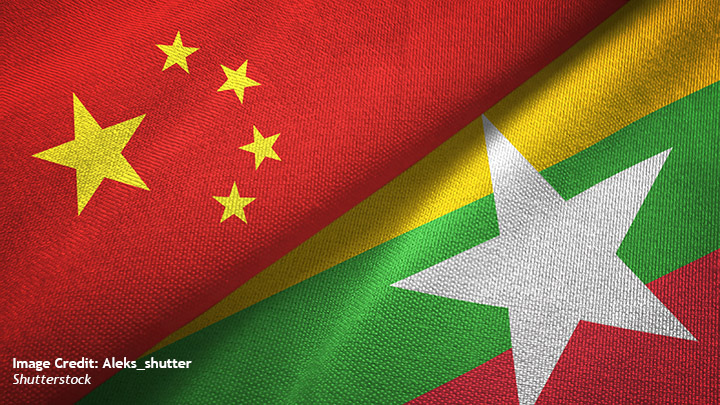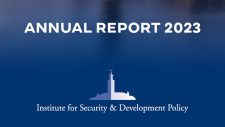Legal Constraints of China’s BRI: The Case of Myanmar

Stephen Crowther
Summary
There are many consequences of China’s global Belt and Road Initiative. Amongst the least appreciated are the legal implications that arise from its investments. In Myanmar, one of the chief destinations for Beijing’s largesse, legal problems often occur at the local level due to land disputes, a lack of transparency or poor public consultation. If these project-related issues cannot easily be settled, some form of dispute resolution is needed between the various states, companies and individuals. Arbitration, mediation and conciliation are several of the most common types, but the framework for resolving such cases has not been fully established. This vacuum adds to the uncertainty surrounding China’s foreign involvement, particularly in developing states like Myanmar.
Introduction
Myanmar is strategically located, connecting China’s southwestern province of Yunnan and South-East Asia on one side, with India and South Asia on the other. A high proportion of China’s maritime trade passes through the Malacca Strait near Singapore, which Chinese officials fear could be closed off by the United States in times of dispute. As a potential solution to this, Myanmar offers indirect access to the Indian Ocean, bypassing the narrow shipping lanes altogether. China’s Belt and Road Initiative (BRI) is its sweeping vision for investment, aiming to connect itself with the rest of the world by creating new land and sea trade routes. The program is less rigid and centrally controlled by China than is often imagined. Indeed, many projects that are now considered part of the BRI in Myanmar were actually proposed years before the scheme officially launched in 2013. The original China-Myanmar Bilateral Investment Treaty was signed in 2001, which underpins cooperation, and outlines how disputes are to be resolved.
In 2018, the two countries agreed the China-Myanmar Economic Corridor (CMEC), to improve transport, energy and trade links. Xi Jinping’s visit to Myanmar in January 2020, the first by any Chinese leader in nearly twenty years, shows the budding state of affairs. The major Chinese investment projects that have either been proposed or built in Myanmar include: the China-Myanmar Railway, the Kyauk Phyu SEZ, the Myitsone hydropower plant, Sino-Myanmar oil and gas pipelines and a high-voltage electricity transmission line. Many of these did not include a competitive tender process for allocating contracts, resulting in Chinese firms usually winning by default.
A host of problems must be overcome in fulfilling the economic ambitions outlined in these agreements. Legal obstacles are a key impediment to China’s BRI engagement. These involve domestic and international disputes between the nations themselves, private companies, state-owned enterprises and individuals. The mechanisms used to resolve these, and the willingness of Burmese citizens and their government to accept them, are of major importance in determining the success of China’s BRI in Myanmar. These topics will be explored in this Issue Brief.
Overview of Sino-Burmese Relations
Before Myanmar’s political opening-up at the start of the 2010s, the relationship with China had been close for several decades. The military administration in Myanmar, with a strong grip on economic and political dealings in society, was relatively trusting of a China run by the Communist Party. The two shared similar priorities in maintaining social stability whilst furthering economic growth. Where they differed, however, was their success in delivering on these goals. Myanmar has been wracked by the world’s longest civil war, which has rumbled on since independence in 1949. Various ethnic minorities, arrayed in a horseshoe along its outer edges, have fought for greater autonomy or outright independence. This has hampered economic growth and isolated Myanmar from its neighbors, with key transits routes being largely closed off. By contrast, a stable domestic environment over the past 40 years has allowed China’s economy to grow spectacularly. Yunnan, the Chinese province that borders Myanmar to the north, is one of the poorer parts of the country, with lower growth than surrounding areas. Despite that, it alone far outshines the entire Burmese economy in terms of overall GDP and average income.
Military rule in Myanmar officially ended in 2011, with the nominally civilian government coming to power. This did not formally signal a loosening of ties with Beijing, as President Thein Sein made sure to visit China within weeks of taking office. However, in reality, Sino-Burmese economic ties frayed as the West ended its sanctions regime and started competing with China as a major investment and aid partner. Chinese companies, who had hitherto largely won contract tenders uncontested, began losing to their foreign counterparts. The Myitsone Dam project, a major 3.4 billion USD hydroelectric power venture that would have been amongst the world’s largest, was cancelled in 2011. The surprise victory of the Aung San Suu Kyi-led National League for Democracy in the openly contested 2015 election also added to the sense of change. She had long been feted as a symbol of human rights and resistance to authoritarianism in her decades under house arrest by the military administration. Myanmar seemed on the cusp of definitively shifting away from China and towards the West.
This made subsequent events in the country all the more surprising. Between 2016 and 2017, conflict between the Burmese army and militants and civilians in Rakhine state, a coastal area in the west of the country, resulted in hundreds of thousands of ethnic Rohingya fleeing into neighboring Bangladesh. The military asserted it had been attacked by separatist Rohingya elements, but the resultant burning of villages and the exodus it sparked led to an enormous humanitarian crisis. Given the newfound powerful position of Aung San Suu Kyi, many in the West expected her to speak out and condemn what were seen as excessive actions by the country’s military. When this was not forthcoming, and amidst allegations of ethnic cleansing by the Burmese army, sanctions were imposed on its armed forces by the EU and others. The type of development aid and assistance that had flowed from the West over the preceding years slowed, and relations drastically cooled. As a result, Beijing was brought back into the fold, with Naypyidaw once again seeking the investments of its large northern neighbor.
BRI Problems in Myanmar: Transparency, Public Consultation and Land Rights
Chinese BRI-related investments have often been criticized for lacking transparency, with it being difficult to know whether there is cause for legal concern if the relevant details remain secret. For example, memorandums and documents related to the CMEC agreement in 2018 have not been made public. Of the 40 projects theorized to exist as part of the scheme, only three have actually been publicly confirmed by the Burmese government.
There is also a lack of project information available in Burmese, meaning local stakeholders find it difficult to understand the consequences of investment. Even where material does exist in English and Chinese, crucial details are often excluded on routings, the companies involved or the underlying project rationales. Frequent discrepancies are apparent in the information provided in Chinese, which is intended for a domestic audience, and that in English, written for international observers. For example, sources in Chinese are normally more approving of the projects in Myanmar, whilst those in English tend to be more critical of the Naypyidaw government. Further, even where there is availability of information in Burmese, this is often not given to local stakeholders. For instance, only five per cent of affected farmers had actually received the final contract during the construction of the Sino-Myanmar oil and gas pipelines.
Legal issues are likelier to arise if the public are not consulted on projects being built in their local areas. The now-cancelled Myitsone Dam mega project was evaluated in an environmental impact assessment in its early stages. It recommended that two smaller dams instead be built, to lessen the harm to local villagers who would be displaced by the huge reservoir. This advice was ignored, and the project was set to proceed anyway had the findings not been leaked to the public. Following a large civil society backlash, the government backed down and was forced to cancel the scheme. Recent evidence does suggest that more consultation is being conducted for BRI-related projects. A feasibility report in 2019 on the long-mooted China-Myanmar Railway sought the views of those living along the proposed route. Though this consultation may only have been of token significance, it represents progress in Myanmar. If ill-considered projects are altered or abandoned entirely as a result of thorough public consultation, the need to resort to legal action in the first place can be reduced.
Land rights are another key disputed issue for BRI projects in the country. Vast tracts of land often need to be requisitioned, with consequences for those who are uprooted, such as landless farmers scrambling to find work locally or being forced to migrate. The customary title to much of the land in Myanmar, especially in the more ethnically diverse borderlands, is often not legally documented or recognized, including communal land ownership. This makes it difficult for legal challenges to be brought in relation to Chinese-backed investment projects. In the case of the Kyauk Phyu SEZ, much of the land chosen for appropriation is considered legally vacant, despite farmers having tilled the land there for generations. Many of the estimated 20,000 farmers and residents who will have to make way for the project are therefore unlikely to receive financial recompense. With insufficient knowledge of their legal rights or access to judicial representation, it is exceptionally difficult for local communities to challenge the appropriation of land.
The Legal Mechanisms for Resolving BRI Disputes in Myanmar
There are a wide variety of stakeholders involved in BRI projects in Myanmar. These range from states, local and regional governments, private companies, state-owned enterprises (SOEs) and individuals. In any given dispute, the parties may be a mix of Burmese or Chinese, meaning that the correct jurisdiction of settlement is unclear. There is therefore a pressing need for an agreed set of mechanisms that would allow cases to go to court or be settled under arbitration or mediation. Arbitration involves an agreed arbitrator making a binding decision on a case, whereas for mediation, an independent mediator helps the parties to try and reach an agreement.
The underdeveloped legal institutions in Myanmar would struggle to deal with the intricate nature of potential cases. Given the marked rise in globalization over the past few decades, there has been a move away from settling disputes in the host country of an investment project, and towards resolution by a third party. The 2001 investment treaty signed by Myanmar and China is an example of this, as it asserts that, if no diplomatic resolution can be found, disputes between the states are to be settled by an “ad hoc arbitral tribunal”. This tribunal is to be composed of three arbitrators; one selected by both countries and a third that these appointees mutually agree on. There is also a provision for the International Court of Justice to select arbitrators if both states do not agree on appointees within a certain timeframe. Similar mechanisms exist for investor-state disputes, with investors able to bring legal action against the Burmese government. Penalties can be handed down even where the relevant laws are in the public interest, so long as they have simply resulted in a loss of investor profits. Stakeholders may also take cases to the International Center for Settlement of Investment Disputes, part of the U.S.-based World Bank.
Despite the existence of these mechanisms, it is interesting that China did not take legal action against Myanmar when it unilaterally cancelled the Myitsone Dam project in 2011. This was despite it clearly being in violation of the contract, and nearly 1 billion USD having been spent by the Chinese SOE in charge. Beijing may have seen the scale of opposition to the project, and felt that legal action would jeopardize its other investment plans in the country. Though the company was within its rights to begin legal proceedings, it evidently took its lead from the central government in not pursuing a case. As SOEs play such a large part in China’s BRI investments, and given their role as effective extensions of the state, it is unsurprising that true control ultimately rests with Beijing. As a result, this fundamentally undermines the entire usefulness of the investor-state legal mechanism.
Given its power over the BRI, China has strong influence over the methods used to resolve disputes. Western legal preferences on international dispute resolution have traditionally been dominant, with these countries generally favoring the more adversarial type, arbitration. As a neutral party makes a binding decision under this method, it promotes a more combative style of settlement, with clear “winners” and “losers” likelier to be produced. However, in China and East Asia more broadly, conciliation is generally the preferred way of resolving disputes. This is similar to mediation, where a neutral umpire tries to bring both sides together to resolve a dispute. Unlike this, though, an impartial conciliator actually makes a proposal to settle the matter, increasing the likelihood that an agreement might be reached. A potential shift in these international preferences would evidence the rising influence of China’s own legal norms, which would be largely attributable to its BRI engagement.
The Struggle Over Where to Resolve BRI Disputes
In 2018, Beijing created the Chinese International Commercial Courts (CICC) to resolve BRI disputes. This consists of two courts handling different parts of the BRI; one in Xi’an to oversee projects related to the land “belt”, and another in Shenzhen for those related to the maritime “road”. It is designed to manage mediation, arbitration as well as litigation to offer a “one stop shop” for all legal issues that arise from BRI projects. Crucially, unlike other similar international courts, the CICC consists only of Chinese judges and its language of operation is Mandarin. Projects can only be referred if the disputes relate to amounts over about 40 million USD. Given that these new courts are overseen and directed by the Supreme People’s Court, the highest court in China, the issue of judicial independence for the CICC is a design feature, rather than a flaw. Beijing has identified an opportunity to provide a faster and more cost-effective alternative to the commercial dispute options that currently exist. This is the same proposition that its BRI advances more generally, offering developing states a different track to the prevailing Western one.
For Myanmar, the new Chinese legal framework presents distinct risks. Allowing Chinese-domiciled courts to rule over projects situated in its own territory and ultimately affecting its own citizens is problematic for its sovereignty. The impartiality of such a Sino-centric body is also a concern, with the suspicion that it would tilt the playing field towards Chinese investors who make use of the new courts. Given that many BRI projects in Myanmar are developed by Chinese SOEs, this raises further barriers to the potential for objective decision making, given the embedded nature of the CICC in the Chinese state. Beijing’s ability to pressure Myanmar and others into making use of these new legal institutions will determine whether they can successfully compete with the current global alternatives. The same is also true for other comparable organizations China has created of late, such as the Asian Infrastructure Investment Bank.
Other international alternatives do exist which could resolve BRI project disputes. Hong Kong and Singapore are the two legal settings seen as likeliest to host the type of arbitration and mediation needed. In Hong Kong, the International Chamber of Commerce and the Hong Kong International Arbitration Centre are two prominent forums which specialize in this field. Singapore hosts similar institutions, with a panel also having been set-up there in coordination with China to resolve BRI disputes. Other international legal centers such as London can also draw from deep wells of experience with dispute resolution. Dubai has also sought to establish itself as a global hub for international dispute resolution, importing some of the foremost foreign legal minds to staff its International Finance Centre Courts. However, China has stated its preference for BRI legal matters to be handled within East Asia. Hong Kong and Singapore have strong knowledge of addressing complex financial legal issues, making them well-placed to do so for BRI schemes.
Conclusion
The legal implications of China’s BRI is an under-explored topic at the global level and for Myanmar more specifically. It is not difficult to see why. There is a complex web of investment contracts, commercial interests, various forms of dispute resolution and political interests to consider. This Issue Brief has attempted to address this deficiency by shining a light on the legal problems affecting Myanmar. The need for a neutral venue to resolve legal disputes is clear, given the lack of capacity in Myanmar and questions over impartiality in China. Recent events in Hong Kong undermine its judicial independence from mainland China. This leaves Singapore in a strong position, given its investments in alternative dispute resolution and geographical location in Asia, an advantage over the West. Myanmar should press China for the use of such a neutral venue as it offers the most realistic option of maintaining its investment interests. However, the current Covid-19 pandemic represents a severe threat to globalization and is destabilizing for the entire international trading system that China’s BRI is predicated on. Even so, cross-border legal expertise may actually be in higher demand in the future due to the likely critical impact on projects, which would seem to favor well-established centers and practices.
China has shown real flexibility in its actions towards Myanmar, particularly after the cancellation of the Myitsone Dam project by the Naypyidaw government. Beijing prioritized amiable relations rather than resort to the legal proceedings it would likely have won. It is this kind of pragmatic approach China needs if it is to establish itself as an international legal powerhouse that the creation of its CICC courts signal. This is especially true given the contractual problems related to debt repayment and construction that have affected many BRI projects globally in recent years. This has soured some of the initial optimism in recipient countries over China’s investments. Ensuring strong legal structures are in place to impartially deal with disputes is in the interests of all parties, from China and Myanmar to firms and local citizens. If Myanmar is to make a success of the bilateral CMEC project China is investing in, its response to this will be a crucial determinant.
Related Publications
-
ISDP Annual Report 2023
ISDP’s Annual Report for the year 2023. We look back on 2023, a year in which tensions and conflicts captured the strategic space in ISDP’s focus areas, making headlines around […]
-
Taiwan and the Diplomatic Squeeze
In mid-March 2023, the self-governing island of Taiwan lost another one of its already few diplomatic allies. Announcing the severing of diplomatic ties between Taiwan and Honduras on Twitter on March 15, […]
-
China’s Health Diplomacy: Taking Forward the Health Silk Road in Southeast Asia
Geopolitical competition over Covid-19 vaccines is at its peak. In the absence of a fair and equitable mechanism to coordinate vaccine access, procurement seems to be based either on nationalistic […]
-
On the Path to Civil War: Beijing Navigates Post-Coup Myanmar
Abstract Protests against the military’s February 1 coup d’état continue in Myanmar. On March 27, the bloodiest day yet, over 114 civilians, including many children, were shot by regime forces. […]



